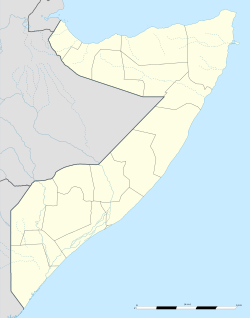
Somalia, officially the Federal Republic of Somalia, is a country in the Horn of Africa. The country is bordered by Ethiopia to the west, Djibouti to the northwest, the Gulf of Aden to the north, the Indian Ocean to the east, and Kenya to the southwest. Somalia has the longest coastline on Africa's mainland. Its terrain consists mainly of plateaus, plains, and highlands. Hot conditions prevail year-round, with periodic monsoon winds and irregular rainfall. Somalia has an estimated population of around 17.1 million, of which over 2 million live in the capital and largest city Mogadishu, and has been described as Africa's most culturally homogeneous country. Around 85% of its residents are ethnic Somalis, who have historically inhabited the country's north. Ethnic minorities are largely concentrated in the south. The official languages of Somalia are Somali and Arabic. Most people in the country are Muslims, the majority of them Sunni.
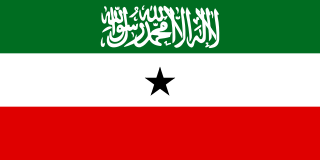
Somaliland, officially the Republic of Somaliland, is a de facto state in the Horn of Africa, considered internationally to be part of Somalia. Somaliland lies in the Horn of Africa, on the southern coast of the Gulf of Aden. It is bordered by Djibouti to the northwest, Ethiopia to the south and west, and the uncontested part of Somalia to the east. Its claimed territory has an area of 176,120 square kilometres (68,000 sq mi), with approximately 5.7 million residents as of 2021. The capital and largest city is Hargeisa. The government of Somaliland regards itself as the successor state to British Somaliland, which, as the briefly independent State of Somaliland, united in 1960 with the Trust Territory of Somaliland to form the Somali Republic.
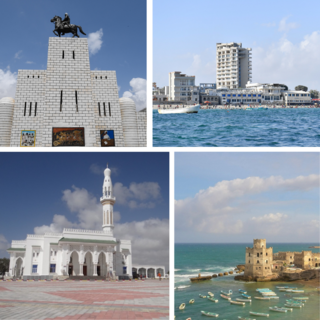
Mogadishu, locally known as Xamar or Hamar, is the capital and most populous city of Somalia. The city has served as an important port connecting with traders all round the Indian Ocean for millennia and has an estimated population of 2,388,000 (2021). Mogadishu is located in the coastal Banadir region on the Indian Ocean, which unlike other Somali regions, is considered a municipality rather than a maamul goboleed.

The Horn of Africa (HoA), also known as the Somali Peninsula, is a large peninsula and geopolitical region in East Africa. Located on the easternmost part of the African mainland, it is the fourth largest peninsula in the world. It is composed of Ethiopia, Eritrea, Somalia and Djibouti; broader definitions also include parts or all of Kenya, Sudan, South Sudan, and Uganda. The term Greater Horn Region (GHR) can additionally include Burundi, Rwanda, and Tanzania. It lies along the southern boundary of the Red Sea and extends hundreds of kilometres into the Guardafui Channel, Gulf of Aden, and Indian Ocean and shares a maritime border with the Arabian Peninsula of Western Asia.
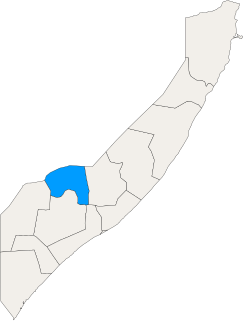
Bakool is a region (gobol) in southwestern Somalia.
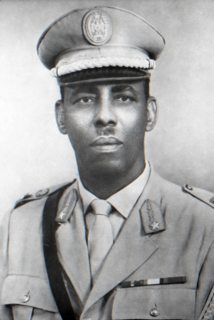
Mohamed Siad Barre was a Somali general who served as the President of the Somali Democratic Republic from 1969 to 1991 and the third overall president of Somalia. He was given the childhood nickname Afweyne roughly referring to extraversion. Barre, a major general of the gendarmerie by profession, became President of Somalia after the 1969 coup d'état that overthrew the Somali Republic following the assassination of President Abdirashid Ali Shermarke. The Supreme Revolutionary Council military junta under Barre reconstituted Somalia as a one-party Marxist–Leninist communist state, renaming the country the Somali Democratic Republic and adopting scientific socialism, with support from the Soviet Union.

Somali is an Afroasiatic language belonging to the Cushitic branch. It is spoken as a mother tongue by Somalis in Greater Somalia and the Somali diaspora. Somali is an official language in Somalia, Somaliland and Ethiopia, and a national language in Djibouti as well as in northeastern Kenya. The Somali language is written officially with the Latin alphabet although the Arabic alphabet and several Somali scripts like Osmanya and the Borama script are informally used.
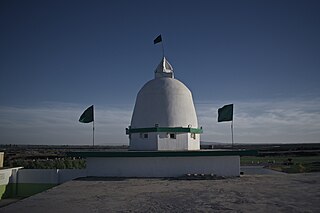
Yarsanism, Ahl-e Haqq or Kaka'i, is a syncretic religion founded by Sultan Sahak in the late 14th century in western Iran. The total number of followers of Yarsanism is estimated to be just over half a million in Iran and Iraq who are mostly Kurds from the Guran, Sanjâbi, Kalhor, Zangana and Jalalvand tribes. Turkic-speaking Yarsan enclaves also exist in Iran.

The Somalis are an ethnic group native to the Horn of Africa who share a common ancestry, culture and history. The Lowland East Cushitic Somali language is the shared mother tongue of ethnic Somalis, which is part of the Cushitic branch of the Afroasiatic language family, and are predominantly Sunni Muslim. They form one of the largest ethnic groups on the African continent, and cover one of the most expansive landmasses by a single ethnic group in Africa.
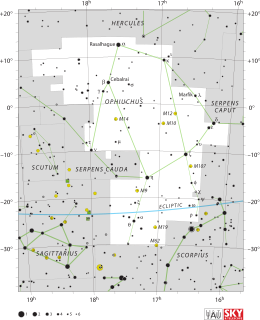
Epsilon Ophiuchi or ε Ophiuchi, formally named Yed Posterior, is a red giant star in the constellation of Ophiuchus. Located less than five degrees south of the celestial equator in the eastern part of the constellation, it forms a naked eye optical double with Delta Ophiuchi. With an apparent visual magnitude of 3.220, the star can be seen with the naked eye from most of the Earth under suitably dark skies. Parallax measurements yield an estimated distance of 106.4 light-years from the Sun.

Delta Ophiuchi, formally named Yed Prior, is a star in the constellation of Ophiuchus. It forms a naked-eye optical double with Epsilon Ophiuchi. The apparent visual magnitude is 2.75, making this a third-magnitude star and the fourth-brightest in the constellation. Parallax measurements from the Hipparcos spacecraft yield a distance estimate of approximately 171 light-years from the Sun.

The Somali Civil War is an ongoing civil war that is taking place in Somalia. It grew out of resistance to the military junta which was led by Siad Barre during the 1980s. From 1988 to 1990, the Somali Armed Forces began engaging in combat against various armed rebel groups, including the Somali Salvation Democratic Front in the northeast, the Somali National Movement in the northwest, and the United Somali Congress in the south. The clan-based armed opposition groups overthrew the Barre government in 1991.
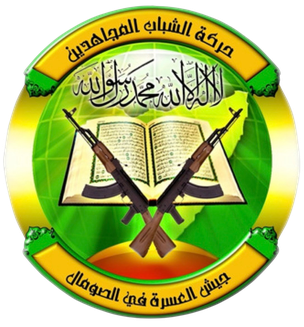
Harakat al-Shabaab al-Mujahideen, more commonly known as al-Shabaab, is a Somalia-based Islamic insurgence group active in East Africa. The group describes itself as waging jihad against "enemies of Islam" and is engaged in combat against the Federal Government of Somalia and the African Union Mission to Somalia (AMISOM). The group has been suspected of having links with al-Qaeda in Islamic Maghreb and Boko Haram. Al-Shabab has often clashed with the Somali Sufi militia Ahlu Sunna Waljama'a. Al-Shabaab’s leaders and commanders are mainly from the Hawiye clan, which is one of the largest clans in Somalia. It has attracted some members from Western countries, including Briton Samantha Lewthwaite and American Abu Mansoor Al-Amriki.
Piracy off the coast of Somalia occurs in the Gulf of Aden, Guardafui Channel and Somali Sea, in Somali territorial waters and other surrounding areas and has a long and troubled history with different perspectives from different communities. It was initially a threat to international fishing vessels, expanding to international shipping since the consolidation of states phase of the Somali Civil War around 2000.

The 2009–present phase of the Somali Civil War is concentrated in southern and central Somalia and portions of north eastern Kenya. It began in early February 2009 with the conflict between the forces of the Federal Government of Somalia, assisted by African Union peacekeeping troops, and various militant groups and factions. The violence has displaced thousands of people in the southern part of the country. The civil war has also seen fighting between the Sufi Ahlu Sunna Waljama'a and al-Shabaab.

District is a district in the southwestern Bakool region of Somalia.
Yed District also known as Yeed District is a district of the southwestern Bakool region of Somalia. Its capital is Yed.
YedZ of E. coli has been examined topologically and has 6 transmembrane segments (TMSs) with both the N- and C-termini localized to the cytoplasm. von Rozycki et al. 2004 identified homologues of YedZ in bacteria and animals. YedZ homologues exhibit conserved histidyl residues in their transmembrane domains that may function in heme binding. Some of the homologues encoded in the genomes of various bacteria have YedZ domains fused to transport, electron transfer and biogenesis proteins. One of the animal homologues is the 6 TMS epithelial plasma membrane antigen of the prostate (STAMP1) that is over-expressed in prostate cancer. Some animal homologues have YedZ domains fused C-terminal to homologues of NADP oxidoreductases.
In July 2022, the Islamist militant group al-Shabaab launched an invasion from Somalia into Ethiopia's Somali Region. Following attacks on the Somali side of the border, the rebel militants initially attacked Ethiopia's Afder Zone on 21 July and occupied the town of Hulhul before being driven back by Somali Region paramilitary forces. On 25 July, the militants launched a second incursion at Ferfer which was also defeated. Further cross-border attacks continued in the following days, while Ethiopia launched counter-attacks in response. Clashes between the Somali rebels and security forces inside Ethiopia extended into early August, and at least one small al-Shabaab contingent succeeded in evading the Ethiopian force and reached its main target, the Bale Mountains.
